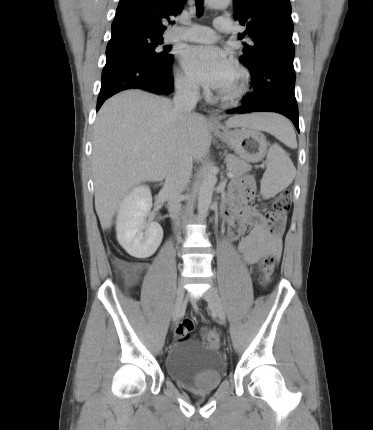Zinner 症候群:罕見精囊腫大造成下泌尿道症狀之個案報告
蔡翰宇、邵翊紘、虞凱傑、張英勛、莊正鏗、馮思中
林口長庚醫院 外科部 泌尿科
Zinner Syndrome: A Rare Condition of Seminal Vesical Mass Causing Lower Urinary Tract Symptoms
Han-Yu Tsai1, Shao I-Hung1, Yu, Kai-Jie1, Ying-Hsu Chang1, Cheng-Keng Chuang1, See-Tong Pang1
1Division of Urology, Department of Surgery, Chang Gung Memorial Hospital, Chang Gung University, Taoyuan, Taiwan
Introduction
Zinner syndrome is a rare condition comprising a triad of unilateral renal agenesis, ipsilateral seminal vesicle obstruction and ipsilateral ejaculatory duct obstruction (1). Here, we present the case of a 32-year-old male with long term lower urinary tract symptoms without seeking any medical attention which later diagnosed with Zinner syndrome on incidental CT finding.
Case Report
A 32-year-old Taiwanese man was referred to urology out-patient department due to an incidental finding of seminal vesicle cyst. He has the underlying diseases of alcoholism and hepatocellular carcinoma. During CT follow up for hepatocellular carcinoma, agenesis of left kidney was noted. Also, a smooth hypodense lesion (3.7 cm) abuts left seminal vesicle with dilated vas deferens was seen. On transrectal ultrasonography reveals a huge cyst 3 x 4 cm bulging from left seminal vesicle. Tracing back his history, he has long term lower urinary tract symptoms including frequency and incomplete emptying. Urodynamic exam was arranged but the results were quite normal. The patient was prescribed with α-blockers and his symptoms improved.
Discussion
Zinner syndrome was first described in 1914. It is a Wolffian duct abnormality comprising a triad of unilateral renal agenesis, ipsilateral seminal vesicle cyst and ejaculatory duct obstruction (1). Clinical presentation may be unspecific and it is caused by a perineal mass-like effect (2). Lower urinary tract symptoms (LUTS) may be present due to the mass effect on the urethra. Also, infertility was reported in 45% of the cases due to ejaculatory duct obstruction (3). Thus, detailed semen analysis is required if the patient has further fertility planning. The diagnosis of this syndrome relies on imaging including CT, MRI, transrectal ultrasound. The method of treatment depends on the symptoms of the patient. Only the symptomatic cases are treated. Percutaneous aspiration of seminal vesicle cyst was reported (4). Recently, robotic

On CT imaging, agenesis of left kidney was noted. A smooth hypodense lesion (3.7 cm) abuts left seminal vesicle suspect seminal vesicle cyst. Also, there is a left pelvic dilated tubular structure connecting to left seminal vesicle favor dilated vas deferens.
assisted excision of mega-seminal vesicle was also reported (5).
References
assisted excision of mega-seminal vesicle was also reported (5).
 On transrectal ultrasound, a 3 x 3 x 4 cm cyst was seen bulging from left seminal vesicle.
|
References
- Shah S, Patel R, Sinha R, Harris M. Zinner syndrome: an unusual cause of bladder outflow obstruction. BJR Case Rep. 2017;3(2):20160094.
- Pereira BJ, Sousa L, Azinhais P, Conceicao P, Borges R, Leao R, et al. Zinner's syndrome: an up-to-date review of the literature based on a clinical case. Andrologia. 2009;41(5):322-30.
- Florim S, Oliveira V, Rocha D. Zinner syndrome presenting with intermittent scrotal pain in a young man. Radiol Case Rep. 2018;13(6):1224-7.
- Kajita Y, Shimizu Y, Takao N, Iwaki H, Yamauchi T. [Seminal vesicle cyst with ipsilateral renal agenesis: a case report]. Hinyokika Kiyo. 2001;47(3):203-6.
- Haddock P, Wagner JR. Seminal vesicle cyst with ipsilateral renal agenesis and ectopic ureter (Zinner syndrome). Urology. 2015;85(5):e41-e2.
附件: